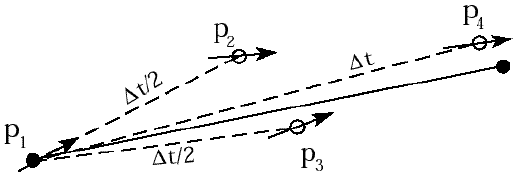Traditionally, a first-order Euler algorithm is used to represent the velocity field and the v/R at the packet position is used to move the packet forward (or backward for modified MOC) for a time step
The limiting criteria for the time step size when considering advection is the Courant number
1st order estimation is OK in areas of uniform velocity, but is not good for strongly converging or diverging flows unless the time step is small
The Fourth-order Runge-Kutta Algorithm is more accurate than the first order because it uses the velocity at 4 locations to determine the net velocity that will influence the packet during a time step.
- The velocity is evaluated at the starting
point, 2 intermediate points and, the end point
Following the first velocity for half a time step to find the location for the second velocity, then using that velocity from the starting point for half a time step to find the third point, then using the average of those 3 velocities for a full time step from the initial position to obtain the location for the fourth velocity.
This calculation requires substantially more computation than the first order algorithm so it is less efficient

MT3D allows options for the first order, fourth order, or a combination of the two to optimize the trade-off between accuracy and efficiency.